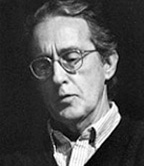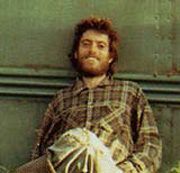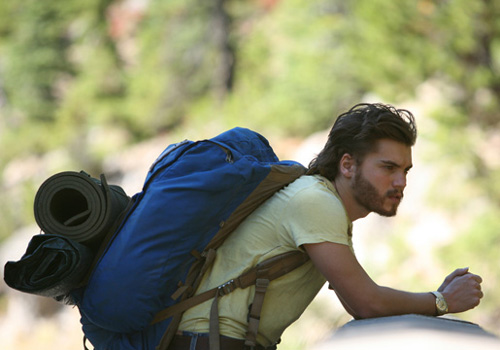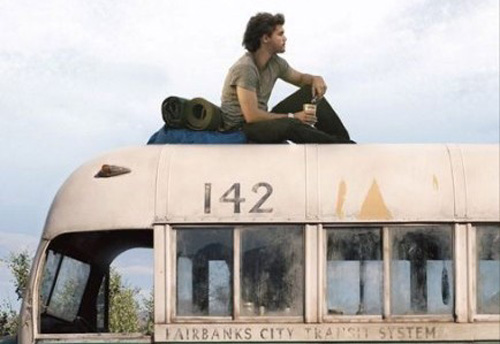|
The physical domain of the country had its counterpart in me. The trails I made led outward into the hills and swamps, but they led inward also. And from the study of things underfoot, and from reading and thinking, came a kind of exploration, myself and the land. In time the two became one in my mind. With the gathering force of an essential thing realizing itself out of early ground, I faced in myself a passionate and tenacious longing—to put away all thought forever, and all the trouble it brings, all but the nearest desire, direct and searching. To take the trail and not look back. Whether on foot, on snowshoes or by sled, into the summer hills and their late freezing shadows—a high blaze, a runner track in the snow would show where I had gone. Let the rest of mankind find me if it could.
This is how John Haines describes his decision to go homesteading in the Alaskan wilderness. This exact quote—from The Stars, the Snow, the Fire, Haines' collection of essays about Alaska—serves as epigraph to Chapter Thirteen of Into the Wild, a book by Jon Krakauer. Similar emotions, so Krakauer surmises, moved Chris McCandless, like Haines a thoughtful and educated young man in his early twenties, to hike into the wilderness near Denali.
Haines spent the better part of forty years, including a stretch of fifteen years straight, homesteading near the Richardson Highway outside Fairbanks, living on what he could hunt or trap in the forests and catch in the rivers. During that time, he began writing some of the finest American poetry and essays of the last half of the twentieth century. In time he published several books, taught writing at schools across the U.S., won a number of grants and awards, and was elected a fellow of the Academy of American Poets. As I write this, Haines, at eighty-three, is finishing up a semester of teaching in the Honors Program at the University of Alaska-Fairbanks. McCandless spent four months in Alaska before starving to death. homesteading near the Richardson Highway outside Fairbanks, living on what he could hunt or trap in the forests and catch in the rivers. During that time, he began writing some of the finest American poetry and essays of the last half of the twentieth century. In time he published several books, taught writing at schools across the U.S., won a number of grants and awards, and was elected a fellow of the Academy of American Poets. As I write this, Haines, at eighty-three, is finishing up a semester of teaching in the Honors Program at the University of Alaska-Fairbanks. McCandless spent four months in Alaska before starving to death.
Many commentators since McCandless' death have seen him as a suicidal fool. Certainly he was sparsely equipped for his Alaskan odyssey, as Krakauer notes in his book and Sean Penn depicts in his new film of it. But, as they both also demonstrate, McCandless was not suicidal and very far from a fool. He wasn't like Timothy Treadwell, though even Treadwell in the end was a greater success than McCandless. Treadwell lasted thirteen summers in the Alaskan bush before he paid the ultimate price for conflating huge, fanged grizzlies with his collection of teddy bears.
Why did McCandless die? According to Krakauer and Penn, he was brought down by a succession of misconceptions and miscalculations such as any newcomer to Alaska might have made.  That probably is true; but there was also, in McCandless' disdain of maps and provisions, a willfulness amounting to hubris. Like Haines, McCandless wanted to be one with the wilderness; unlike Haines, McCandless wanted to compete with it and beat it, to become its master. John Felstiner, in his recent American Poetry Review essay on Haines, noted that Haines said of himself and the old Alaska homesteaders, "(T)hey'd begin telling stories, and I'm just sitting there listening to them." Krakauer's book is filled with instances of McCandless imperiously ignoring advice from family, friends, and acquaintances; he listened to nothing except his own inner voice. "He didn't think the odds applied to him," Krakauer quotes McCandless' father as saying. "We were always trying to pull him back from the edge." McCandless might seek specific bits of information, but—as Krakauer shows—he couldn't always place such information in the right context. For instance, he never stopped to think that the advice of South Dakota hunters on how to preserve a fresh deer carcass might not be applicable to an Alaskan moose. (That error had catastrophic implications for McCandless, as both the book and movie demonstrate.) That probably is true; but there was also, in McCandless' disdain of maps and provisions, a willfulness amounting to hubris. Like Haines, McCandless wanted to be one with the wilderness; unlike Haines, McCandless wanted to compete with it and beat it, to become its master. John Felstiner, in his recent American Poetry Review essay on Haines, noted that Haines said of himself and the old Alaska homesteaders, "(T)hey'd begin telling stories, and I'm just sitting there listening to them." Krakauer's book is filled with instances of McCandless imperiously ignoring advice from family, friends, and acquaintances; he listened to nothing except his own inner voice. "He didn't think the odds applied to him," Krakauer quotes McCandless' father as saying. "We were always trying to pull him back from the edge." McCandless might seek specific bits of information, but—as Krakauer shows—he couldn't always place such information in the right context. For instance, he never stopped to think that the advice of South Dakota hunters on how to preserve a fresh deer carcass might not be applicable to an Alaskan moose. (That error had catastrophic implications for McCandless, as both the book and movie demonstrate.)
"McCandless wasn't some feckless slacker, adrift and confused, wracked by existential despair," Krakauer writes. "To the contrary: His life hummed with meaning and purpose. But the meaning he wrested from existence lay beyond the comfortable path: McCandless distrusted the value of things that came easily. He demanded much of himself—more, in the end, than he could deliver." Except for the last half-sentence, this entire passage is also true of Haines. And in that half-sentence lies all the difference. Haines scholar Steven B. Rogers, in "Stories I Have Listened To," his essay on Haines, McCandless, and Alaska, is blunt: "Being alone in the Alaskan wilderness can, for some, be a richly rewarding experience, but nature is unforgiving to those who do not show it the respect it deserves and demands."
In the book of Into the Wild, Krakauer—an experienced outdoorsman and mountain climber—gives instances of his own youthful lack of respect for nature, particularly his early adventure climbing the Devils Thumb in the Stikine Ice Cap on the Alaska-British Columbia border. Like McCandless, he went in full of willful joy. Like McCandless, he made a lot of rookie mistakes. Unlike McCandless, he lived to tell the tale. That Krakauer sees McCandless as a brother, and is filled with rueful admiration for him, is beyond doubt.
Krakauer is on record as loving Sean Penn's film of Into the Wild, and the two men have become friends. I saw bits and pieces of the "Iconoclasts" program featuring Penn and Krakauer on the Sundance Channel Web site. "This guy is just a force of nature," Krakauer says of Penn at one point. "He does what he wants, when he wants, the way he wants it, and he does not give a rat's ass what anyone else thinks."
As soon as I heard that, I found myself thinking, "Who does that sound like?"
In other words, Penn's film of Into the Wild is as close as we can possibly get to McCandless making a film about himself. What Krakauer admires about McCandless regretfully and qualifiedly, Penn admires wholeheartedly. Penn is famous as being one of the most outspoken of Hollywood stars, a group not generally known for being replete with wallflowers, and McCandless' very recklessness is precisely what appeals to him. Hollywood, like few other places in the world and definitely unlike the Alaskan wilderness, regularly rewards outsized personalities and grandiose gestures. Is it any wonder, then, that Penn's film comes perilously close to hagiography?
Most people who see Penn's movie will be ravished by it, because it is beautifully made and above all gorgeously photographed. Eric Gautier, the master cinematographer who shot an earlier cinematic paean to a young wanderer (Walter Salles' The Motorcycle Diaries), presents McCandless' two years of peregrinations in glowing images that would make Albert Bierstadt's mouth water. The frosty heights of Denali shudder under ethereal mists, the sands of the Mojave sparkle like burnished gold, the waves of the Pacific are cascades of sapphires, the wheat fields of South Dakota wave gracefully at a benevolent azure sky. And in the midst of it all is McCandless, his leonine mane of dark hair blowing in the wind, piloting his kayak down simmering rapids or running free with wild horses in a ruddy sunset, all to the tune of Eddie Vedder's fine and mournful songs.

The main problem with filming Krakauer's book is that, except for a few letters and postcards and some sketchy journal entries, McCandless left nothing about his travels. Most of the information we have comes from Krakauer's indefatigable detective work in tracking down everyone who shared a campsite with McCandless, gave him temporary work or offered him a ride. To make a biographical movie, however, you have to tell the story from the subject's point of view. Penn in his screenplay, while generally remaining faithful to the source, negotiates the gaps in the story—as he must—with various inventions and expansions. A run-in with a railway bull, which McCandless referred to, in passing and almost jokingly, in a letter to a friend, becomes the most brutal and terrifying set piece in the film. A teenage girl's chaste crush on McCandless, mentioned in one paragraph in Krakauer's book, becomes a campfire duet between McCandless and the girl of John Prine's "Angel from Montgomery." A few of Penn's pure inventions verge on the risible, such as McCandless' peaceful encounter with a grizzly late in the film. (I know of a couple of native Alaskans who really got a cackle out of that one.)
What Penn chooses to exclude is just as telling as what he chooses to expand. One of the most fateful points in both the book and the movie is when McCandless, having crossed a peaceful, burbling Teklanika River in the spring, discovers to his horror a murderous, uncrossable torrent in the summer when he tries to go back to civilization. What Krakauer tells us—and Penn doesn't—is that a few miles upriver there was an aluminum basket suspended by a steel cable that hunters and government scientists used to cross the river. If McCandless had brought a topographical map, he'd have known about the basket. This information may well have been too expository to fit comfortably into the movie, and Penn may have rejected it on that basis alone. But excluding it also adds to the presentation of McCandless as a pure victim of fate.
Because a narrator is necessary to piece together McCandless' story, and putting Krakauer in the movie would have been intrusive in the extreme, Penn chooses McCandless' sister Carine to fill that role. That was a smart choice: Carine, though she never heard from Chris during his last two years, was closer to him than anyone, and among all the film's characters was in a unique position to interpret the family tensions and secrets that drove her brother away. But—perhaps because of the spin Penn gives the words he puts in Carine's mouth—Chris and Carine's parents, Walt and Billie McCandless, are less sympathetic in the film than they are in the book. Penn strongly suggests that Chris was changed for the better by his sufferings in the wilderness, and Walt and Billie likewise were changed for the better by their son's two-year disappearance. They were ready to be a family again, Penn tells us, and only Chris' death prevented it. Krakauer makes no such claim. A scrawled sentence in one of Chris' books may have indicated his conclusion that happiness must be shared, but, as Krakauer points out, we can never know what was truly in Chris' mind when he breathed his last on the abandoned Bus 142. Similarly, Walt and Billie's suffering in the book was like the suffering of worried, grieving parents anywhere, with no apparent lessons learned except the grief itself. (Penn acknowledges that, in their stubbornness and inflexibility, Walt and Chris were truly father and son. He finds a clever visual way, suggested in the book, of showing this: their mutual dislike of wearing socks.)

You would expect Penn, one of our greatest actors, to be a superb director of actors, and he lives up to those expectations. By all accounts, Chris McCandless inspired trust and affection wherever he went, and Emile Hirsch inspires similar feelings playing McCandless, both as character and as actor. Like Tom Hanks in Cast Away, Hirsch shed a great deal of weight from his already slender frame to play a man starving in the wilderness. However, it wasn't Hirsch's gaunt frame I remembered from Into the Wild, or even the arduous physical exertion his role required, but his honest, mobile face and eyes, his emotional directness, his simultaneous and endearing projection of sturdiness and vulnerability. The film's last ten minutes are as heartbreaking as you would expect, thanks to Hirsch's superb portrayal of McCandless's terror, desperation, and final resignation.
The characters McCandless meets along the way are mostly as memorable as McCandless himself, thanks to Penn's careful casting. Brian Dierker—a Grand Canyon river guide whose first acting job this is—is a natural as "rubber tramp" Rainey, and the excellent actress Catherine Keener is moving as Rainey's partner Jan, who sees her long-absent son in Chris. Vince Vaughn, given a vacation from playing the perpetual joker, is a tower of regular-guy strength as wheat harvester Wayne Westerberg, who employed and befriended McCandless until the fabrication of illegal TV-satellite boxes put him in jail. (Penn depicts Westerberg's arrest, but offers no explanation.) William Hurt, Marcia Gay Harden and Jena Malone do their usual expert jobs as Walt, Billie and Carine McCandless, although Penn keeps them somewhat nebulous. The most powerful supporting performance is by the octogenarian Hal Holbrook (these days looking more like T.S. Eliot than Mark Twain) as desert dweller Ron Franz, a retired military officer whose wife and son were killed long before in an auto accident. Seeing in McCandless the grandson he might have had, Holbrook's Franz is a moving example of exactly how to play dignified emotion on screen.
Of course, these are the ramblings of a reviewer who has never visited Alaska and has in the bargain a hobbit-like aversion to wilderness adventure. No one mentioned in this review—not Sean Penn, not Jon Krakauer, not Emile Hirsch or Eddie Vedder or Hal Holbrook—will give a rat's ass what I think of Into the Wild. And neither will the old man who, looking out his window at a Fairbanks sunset, may remember what he wrote years ago in "Poem of the Forgotten:"
I came to this place,
a young man green and lonely.
Well quit of the world,
I framed a house of moss and timber,
called it a home,
and sat in the warm evenings
singing to myself as a man sings
when he knows there is no one to hear.
I made my bed under the shadow
of leaves, and awoke
in the first snow of autumn,
filled with silence.
|
|

